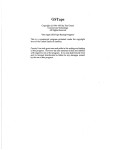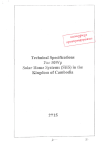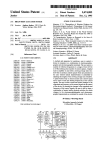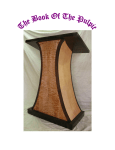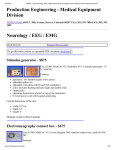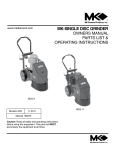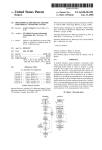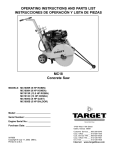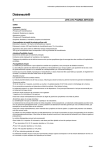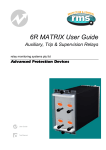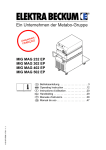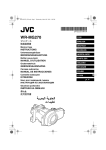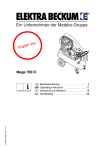Download Electro-convulsive therapy (ECT) system with enhanced safety
Transcript
US006014587A
United States Patent [19]
[11]
Patent Number:
6,014,587
Shaw et al.
[45]
Date of Patent:
Jan. 11, 2000
[54] ELECTRO-CONVULSIVE THERAPY (ECT)
Deutsche Elektrotechnische Kommission Prestandard DIN
SYSTEM WITH ENHANCED SAFETY
FEATURES
V VDE 0801 Principles for Computers in Safety—Related
[75]
Systems (2d Proof English Translation) pp. 33, 37—39, 68,
69, 78 and 106 (Oct. 1991).
Inventors: John B. Shaw; Richard A.
Sunderland, both of Aloha, Oreg.
[73] Assignee: Mecta Corporation, Lake OsWego,
SWartZ, Conrad M. and Abrams, Richard, ECT Instruction
Manual, pp. 6—27; 40—51; 59—70 and Table 2, Jan., 1994.
Thymatron DGx, 3 pages, 1994.
Oreg.
(List continued on next page.)
[21] Appl. No.: 08/933,186
[22] Filed:
Sep. 18, 1997
Primary Examiner—Jeffrey R. JastrZab
Attorney, Agent, or Firm—Marger Johnson & McCollom,
Related US. Application Data
PC.
[62]
Division of application No. 08/562,336, Nov. 24, 1995,
abandoned.
[51]
[57]
Int. Cl.7 ..................................................... .. A61N 1/08
[52] US. Cl.
[58]
607/45; 607/63; 607/72
Field of Search ................................ .. 607/45, 46, 63,
607/72
[56]
References Cited
3/1948
Offner ..................................... .. 607/45
4,184,485
1/1980 Agoston .
4,363,324
12/1982 Kusserow .
4,777,952
4,870,969
4,873,981
4,878,498
4,940,058
5,237,991
5,269,302
10/1988
10/1989
10/1989
11/1989
7/1990
8/1993
12/1993
Pavel .
SWartZ .
Abrams et al. .
Abrams et al. .
Taff et al. .
Baker, Jr. et al. ...................... .. 607/27
SWartZ et al. .
5,470,347
11/1995
SWartZ et al. ........................... .. 607/45
FOREIGN PATENT DOCUMENTS
2057889A
4/1981
An electro-convulsive therapy (ECT) system includes both
hardware and software safety detectors and monitors gen
erator that generates a pulse train of a plurality of pulses With
parameters speci?ed by the user. The safety monitors moni
tor these user-speci?ed parameters as Well as other impor
tant pulse parameters both during treatment of a patient and
prior to treatment in order to ensure that the system is
U.S. PATENT DOCUMENTS
2,438,875
ABSTRACT
United Kingdom.
operating according to speci?cation and, therefore, Will not
injure the patient. The pulse generator is responsive to the
safety monitors in that if any of the safety detectors detect
a parameter that is out of tolerance, the safety monitor
disables the pulse generator so that no further pulses are
delivered to the patient. The safety detectors detect the
plurality of pulse characteristics including pulse Width,
frequency, voltage, current, treatment duration, as Well as
energy. In addition to these real time safety checks, the
system includes a pre-treatment arming routine that applies
a pre-treatment ECT pulse train to an internal load and
monitors these same parameters during this internal test. If
all of these parameters are Within tolerance, the system
moves to an armed state in Which the user can proceed to
apply an ECT treatment pulse train. If any one of these
OTHER PUBLICATIONS
safety checks fails, hoWever, the system does not arm and,
Microcomputers in Safety Technique, by H. Holscher and J.
Rader, pp. 3—7, 8; 3—11,12; 4—5,6; 4—15, 16 and 7—5, 6
therefore, prohibits treatment.
34 Claims, 16 Drawing Sheets
(1984).
, 2222222222 2,
\COMF'UTER
1
SYSTEM 45
ANALOG l
‘
OUTPUT
:7
I
,
smutz
52}l
0pm’
l
1
ISOLATOR
\
ISOLATED
1
SERIALS} 1
;
‘DATA output)
FTIGOE
6,014,587
Page 2
OTHER PUBLICATIONS
Mecta Domestic Service Manual, Rev. 9900—0010, pp.
13—41, 1985.
HeWlett Packard De?brillator, Model 43130A—1, p. 2—4,
1985—1986.
UFI Model 1020 PPG, 2 pages, Jul. 1985.
Mecta Domestic Instruction Manual, Rev. 9900—1008, pp.
Physio—Control Corporation, LIFEPAK 9P, pp. 1—16 and
1—13; 28—55; 60—74, 1985.
Strong, Peter, Biophysical Measurements, pp. 104—105,
5—41.
1970.
WidroW, Bernard and Stearns, Samuel D., Adaptive Signal
Processing, Chapter 6, pp. 99—101, 1985.
U.S. Patent
Jan. 11,2000
CET SAMPLE
ESTIMATE
ERROR
6,014,587
$202
w
FREQ, PHASE, AMP
CALCULATE
Sheet 2 0f 16
204
w
206
18
\
V
ADJUST
FREQ, PHASE, AMP
w
T TTTTTTTT "T’TT
208 |
:
USER
INTERFACE
:
,
|
:
l
KNOBS
'
l
: 2O~/
} I \
§
TOUCH
I
I
SCREEN —*—'—I
; 22J
I
|
l
:
LCD
<—}-—
1
: 24~/
:
{
l
l
1
CHART
RECORI>ER‘_E_i "T
<
iZGJ
I
I
|
(--+-———
SPEAKER
'
I
:
|
|
l
LEDS
I
{ ISOJ
I‘
I
:
STIMULUS _-l--_
CONTROL
1
{ 52J
{
1
1
:
REMOTE
CONTROL —*—"'|,
' 54d
LL
|
'
: 28~/
>2
'
E
U.S. Patent
Jan. 11,2000
178"\
Sheet 7 0f 16
6,014,587
‘
INITIALIZE
180
INT ?
‘182'\
NO A
YES
READ DATA
184w
{
FILTER DATA
186P\
‘L
192\
DECIMATE
( +2)
188\
4
DECIMATE
( + 3)
190#\
$
J,
DECIMATE
( +11)
194\
{
TRANSMIT To
RRocEssoR
196'\
TRANsMIT
TO D/A
(CHART
REcoRDER)
&
DECIMATE
( -:-2)
198'\
‘
TRANSMIT To
RRocEssoR
1
FIG.5
(LCD)
U.S. Patent
Jan. 11,2000
Sheet 9 0f 16
6,014,587
50%
H
5
1
0
3
m
“
JN2mxR08N3
Hm3SN|P<
.5720-Hw1
Q252m%o.i/m
3N\amwitXzm2k,
w
4
__m5
<
o
1
5
i
'
3
z
1
%
o
9
2
w
w
m
8
a
0
x
/
4
l
?
@
R
.
0
1
\
mx
3
m
/
t
5
n
m
2
*
H
XWN
w
i
2
0
2
N0wmNwwm w?zoh
0m
m
.mg
w3NszT>wlmw
w;S1>EL'mNN
Q
O
a
O
A
U.S. Patent
Jan. 11,2000
Sheet 10 0f 16
6,014,587
@|Z|NZ
OIQIN<
5
:4
mmmmgmO
nu.02<\@252% O
wz
mmmX@QWNw
mmwi5E02w50<0\@
OTUE
ww
U.S. Patent
Jan. 11,2000
Sheet 11 0f 16
6,014,587
VCC
S13
TREAT_RELEASE
“JOTHZ 402357‘
3 1
I
l
1
CURRENT
MONITORING
i
RC_SENSE
O
T
404
v
I
IS CURRENT
HIGH ENOUGH
I
l
O/fo
T
FRONT
I
514',O—-
G
TO INDICATE
A REMOTE
l
i O
PANEL
SWITCH
515 I
'
O/“S
)
CONTROL IS
CONNECTED ?
»
—O/*"O—:_
,
é
FRONT RANEL
START_TREAT
+
99
_
>l--l
POWER 3 g
LL
FRONT PANEL
SELF TEST
SELF_TEST
O——TO
Z-JDULSE
0
O
l—
RULSE ORIvER
OUTPUTS
FROM FIO.12B
AC CURRENT
<5
552
SOURCE
3
550
CNTL1
O
FIG.11A
—
U.S. Patent
Jan. 11,2000
Sheet 12 0f 16
6,014,587
r _____________________________________ ____
;\I\
I
3?
[)3
ISOLATED
cIROUITs
1
REMOTE
I
SUPPLY
m
Hgm
OONTROL
;
POWER
;
I
400
FIGJIB
J
R8
W»
I
542
1
0/0
XK—
I 0mm?
D1
546
o/vou
558
1
:
i
FIGR.‘O1MA
LD_—<S>ONTL2
344 PAOOLE
I O
I
'
D2
R7
‘
’\/V\/
1
TREAT
511
$12
|
DUMMY
1
»—O/O—
:
LOAD
;
TEST
R1L/\
‘
HW_SD
_
554
R11
1
T
‘
1 [ T2
U}
OPT. REM. ONTL
U
0
\—__':T__‘____—I_“ m _ _
_
556
3
. _ _ _ _ _ m _ __Z_)q>_8___56_6____P_/5_|:)_D_E_E~
fwYqTs
OELIv_I
OURRENT
MONITORING_"
——>
————9DELIV_P
396
388
390
g
3
L548 k364
VOLTAGE
ANALOG
MONITORING
MULTIPLIER
_ \égEB/CEEICTQ
CONVERTOR
IMP
CLOCK
|__
OELI\/_v
554
[———ODI\/IDEF2_SELECT
592 CLOCK
_O‘/O—"—"OJOULE_CLK
LCOUNTERS
CLOCK 2
__
MAX ENERGY
RESET
LIMIT SELECT
558A
IO
T
PRECISION
REOTIEIER
356
ENERGY-MAX
:
“394
LOW
FILTER
PAss
598
562
Z
560
U.S. Patent
Jan. 11,2000
Sheet 13 0f 16
6,014,587
450 \
452
WD_RESET%RESET
5 mSEC
WD_OLT<OC——>OLOOK WATCHDOG
ENERGY_MAX
S20
\
r426
460 I0
TREAT__RELEASE
T
5—COLOR
CONTROL
416
414'\
412
DAG
STLAETDUS
TO
FIG-11
CNTLC?E
456\
424\
186 HZ
LOGIC
OSCILLATOR
T I
@458
_
RESET ONE
CLOCK SHOT _
ONT|_2
410
502
2
CNTL1C)>
446
422 J
420
m
@
>0‘
418
E
RESET
0
|__
LEDGO
508\
‘
500
298
FREOUENOY_
T 2
S
8
MAX
PULSE__IN
MAX PULSE
FREQUENCY
LIMITER
WIDTH
8'
504
318
502
PULSE_LEVELé
FIGJZA
LIMITER
506i
—
U.S. Patent
Jan. 11,2000
Sheet 14 0f 16
6,014,587
TIMER_EXPIRED
X
0/‘458
WD_EAILURE
‘) 428
HW_SD
448
CLOCK 1O SECOND
44O
RESET
TIMER
4
g
PULSE
444
+5OVDC
STRETCHED
2__|:>ULSE
462
RATIENT__GONNEOTEO
324\
4
+20 VOLT
FIRG.O12MA
480
(ti-478 482
REGULATOR
‘
TONE
526
476
<5 1*
SWITCHING
POWER SUPPLY
+5OVDC
+55 VOLT
X65
NOT RUNNING
REGULATOR
484
+35V/8
OUT 1_
L
_
‘5%’
>— X.125 ———0
SELECT
LINES
314
+
____,
ANALOG
TO
MUX
}
POWER FIG.11A
INRUTS
OUT
2
522
Q2
—
w’
+
g
510
X'9
_
‘MI’ '
466
EXTENOER
g
450
S210
454
I516
464
_)
3
LOGIC $442
458
%
RULSE_OUT
'
’
33OJ‘CURRENT l 5R6 +
MAX
LIMIT
_
7
FIGJZB
U.S. Patent
Jan. 11,2000
Sheet 15 0f 16
6,014,587
0m
@50.
\\wmQ1is
<5%
__
__
Qa
[g
wn?l
Tli2mw0.3ELzoin:w
L1m?lJDQoISE
$¢o
AQHmagi 1
m::>——o8
U.S. Patent
Jan. 11,2000
f@om
0mmmDSzEoCmt
@5/SNEDQ 25:3J6E
mwo3m:ws20z 503:71
@50:3E
Sheet 16 0f 16
Nm0250%;
w5>3n%D\mE?5I/BE
\mDoSECm2%g
29j3mM5g2
\195
T36
Q2m>0OQ
a
mOUQ
3m
m
i
z
m6g<oiun2m 2J5m Qzo0t:n53m;2$2g58 m
0m
>@BLFmBH>
25m
mk ; \lo m
Emo?m
6,014,587
6,014,587
1
2
ELECTRO-CONVULSIVE THERAPY (ECT)
available therapeutic alternatives. Until the day comes When
more effective and less toxic drugs or procedures become
available, it is likely that ECT Will continue to be used.
SYSTEM WITH ENHANCED SAFETY
FEATURES
In their initial use of ECT, Cerletti and Bini Were quite
uncertain and apprehensive as to the proper means of
This is a division of application Ser. No. 08/562,336,
?led on Nov. 24, 1995, noW abandoned.
stimulus dosage. Consequently, the ?rst ECT machine Was
a rather complicated, ornate-appearing device, With numer
ous dials, buttons and controls. The type of electrical signal
utiliZed by Cerletti and Bini Was the sine Wave, Which is
What is present in electrical sockets in homes and of?ces. As
BACKGROUND OF THE INVENTION
In the early portions of the TWentieth Century, there Was
a great feeling of desperation Within the mental health
community. Mental health hospitals Were ?lled With thou
sands upon thousands of severely and chronically ill
individuals, predominantly schiZophrenic, for Whom there
one Would expect, this type of stimulus Waveform Was
utiliZed because of its ready availability. If one looks on an
oscilloscope, the household sine Wave represents an undu
Were no viable means of therapy. Acting upon some erro
lating pattern of voltage or current, varying With time and
neous data Which indicated that there appeared to be an 15 repeating ?fty to sixty times a second depending on the
country.
antagonism betWeen schiZophrenia and epilepsy, the Hun
garian neuropsychiatrist, Meduna, attempted to induce sei
Zures in schiZophrenics by injecting oil of camphor intra
muscularly. Within a year folloWing his initial successful
report of such use in the management of schiZophrenia in
FolloWing the initial reports of actual stimulus parameters
required to induce a seiZure, in the absence of data pointing
toWard any direct electrical damage upon the organisms
20
from such dosage levels, there Was a drift among ECT
1935, neWs of the use of induced seiZures for such a purpose
device manufacturers to simpler and simpler devices. In
spread around the World. A long, hoped for breakthrough
some settings, this resulted in the use of stimulus electrodes
Which Were plugged directly into a Wall socket. In most
cases, hoWever, at least the presence of an “ON” button,
along With a control for increasing or decreasing voltage or
current, Was present.
had noW occurred.
Producing seiZures With the use of camphor, hoWever,
Was by no means a pleasant or even reliable task. Even
25
though camphor Was almost immediately replaced by a pure
pharmacologic preparation, pentylenetetraZol (or MetraZol),
the use of this technique Was still hampered by the presence
of painful myoclonic contractions occurring prior to seiZure
onset. Occasionally, dif?culty in inducing seiZures at all,
30
lack of predictability When the seiZure Would occur, and the
possible presence of prolonged and recurrent seiZure activ
ity. Still, the therapeutic bene?ts of pharmacoconvulsive
therapy, as it Was called, clearly appeared to outWeigh the
dif?culties.
35
The early discovery that induced seiZures Were associated
With confusion and amnesia, hoWever, led researchers to try
and experiment With the nature of electrical stimulus, under
the assumption that more energy-ef?cient stimuli might have
less detrimental side effects. By the mid- 1940’s, Lieberson
and colleagues had found that an interrupted stimulus
pattern, consisting of brief, rapidly rising and falling pulses
of electricity, separated by longer periods of electrical
Among those Who Were impressed by the early successes
inactivity, offered the promise of producing seiZures on a
more ef?cient basis With seemingly less confusion and
of pentylenetetraZol-induced seiZures Was the Italian
neuropsychiatrist, Cerletti, Who Was at that time heavily
involved in epilepsy research, using electrical stimulation to
either not aWare of or Were not impressed by this data. There
Was a feeling that the confusion and amnesia Were either
amnesia. Unfortunately, most practicing psychiatrists Were
40
Zures in humans could be produced more easily and in a
manner more tolerable to patients, Cerletti and his colleague,
unimportant or perhaps even useful therapeutically. In
addition, there Were severe methodological problems With
their early studies, as there Were almost universally With
Bini, attempted to use their techniques clinically in 1937.
investigations taking place during this time period.
produce seiZures in animals. Believing that therapeutic sei
The success of their initial report of such use in 1938 Was 45 Accordingly, the use of the sine Wave stimulus, at least in the
US, continued to be extremely Widespread into the 1970’s.
In the mid-1970’s the late psychiatrist and prominent ECT
heralded by psychiatrists as a signi?cant improvement in the
form of convulsive technique, and Within one or tWo years
had spread into clinical practice on a WorldWide basis.
researcher, Paul Blachley, decided that, given the degree of
During the 1940’s and throughout much of the 1950’s
electro-convulsive therapy (ECT) Was a mainstay of psy
concern over memory de?cits Which had arisen during the
50
ongoing controversy over unilaterally, nondominant versus
bilateral electrode placement, an attempt should once more
chiatric management of severe mental health disorders. As
With any poWerful neW form of treatment, it Was used on an
be made to offer an option of brief-pulse stimulus Waveform
extremely Widespread basis. Over the course of this period
With ECT devices. In addition, Blachley felt that this “opti
mal” device should also incorporate the capacity of moni
of its use, it became clear that While ECT Was occasionally
useful at treating schiZophrenia, its effects Were even more 55 toring both EEG and ECG; and should offer the user a clear
means to test the safety of the electrical circuit before
bene?cial in the management of severe affective disorders,
particularly major depressive episodes. With the develop
delivering the stimulus; and ?nally, that it should be able to
ment of effective psychotropic alternatives for treating
schiZophrenia and affective disorders, beginning in the mid
offer the ability to alloW careful titration to individuals’
1950’s, the use of ECT began to decline.
At present, ECT is used sparingly. It is estimated that in
the US, only three to ?ve percent of psychiatric in-patients
receive this treatment modally, and that betWeen 30,000 to
100,000 patients per year are involved. Many psychiatrists
seiZure thresholds. After design and testing efforts, this
60
device, Which Was knoWn as the MECTA (Monitored
Electro-Convulsive Therapy Apparatus) Went on the market
in 1977, and readily greW in popularity over the folloWing
years.
Based on a number of developments in the research
believe that the decline in ECT utiliZation has noW reached 65 literature, and comments and suggestions by psychiatrists
a turning point, in that there noW appears to be a groWing
using ECT devices, a neW generation of MECTA devices
Was placed on the market. This neW generation included the
acceptance of its continual clinical role With respect to
6,014,587
3
4
SR and JR models manufactured and sold by MECTA
?ed on the front panel, the estimated energy Will not equal
Corporation, of Lake OsWego, Oreg. Although this neW
generation of ECT devices Was an improvement over eXist
the actual delivered energy. As a result, the clinician can be
misled as to the actual delivered energy.
ing devices in terms of safety, effectiveness and ease of use,
there Were still additional improvements to be made in all of
Accordingly, a need remains for improved parameter
monitoring both prior to and during ECT treatment.
these areas.
SUMMARY OF THE INVENTION
The SR and JR models include tWo safety features. The
?rst feature uses a “self-test.” Despite its name, the “self
test” does not test the device itself but instead measures the
It is, therefore, an object of the invention to improve the
safety and reliability of ECT devices.
static patient impedance prior to application of an ECT
stimulus. The clinician instigates this test by pushing a
self-test button on the device after the ECT electrodes are
Another object of the invention is to automate the safety
test procedure.
A further object of the invention is to improve the quality
positioned on the patient. The ECT device then measures the
of measured patient monitoring signals.
impedance running from the ECT device through an ECT
electrode, the patient, the other ECT electrode, and back to
the device. During the self-test, the device passes a minute
15
A yet further object of the invention is to provide an
improved method and apparatus for monitoring seiZure
activity.
current through the circuit. These models measure the
The invention is an electro-convulsive therapy (ECT)
system With advanced safety features. The system includes
impedance by measuring the voltage produced across the
circuit and dividing that measured voltage by an assumed
a means for applying a train of ECT treatment pulses to a
current level. The calculated static impedance is then com
patient, a plurality of pulse train parameter detectors that
pared to a predetermined range of static impedances. If the
calculated static impedance is Within that range, the self-test
passes. OtherWise, the self-test fails.
each detect a respective pulse train parameter, and a corre
sponding plurality of pulse train parameter monitors that
If the static patient impedance is outside the acceptable
disable the applying means if the detected pulse train
parameter falls outside of a predetermined range of accept
range, the device inhibits delivery of an ECT stimulus unless
able values. The monitors operate on a pulse-by-pulse basis
an “impedance override” button is pressed. The impedance
override button alloWs clinicians to bypass the self-test
and, therefore, provide added safety by terminating a treat
ment if any of the measured parameters are outside their
speci?ed tolerances. This ensures that a safe and effective
treatment is applied to the patients in the event a component
or circuit fails or drifts out of calibration prior to or during
failure and engage a stimulus delivery sequence Where the
eXtreme static impedance value is due to a peculiar patient’s
characteristics.
The SR and JR models from MECTA also alloW the
clinician or other technician to verify that the device is
operating Within their speci?ed tolerances. This is accom
plished by connecting the stimulus output of the device to an
external resistor substitution boX, i.e., a “dummy” load. A
stimulus sequence can then be applied to the dummy load
and the resulting signal’s characteristics can be measured
treatment.
The system monitors all of the relevant pulse train signal
parameters: voltage, current, pulse Width, frequency, pulse
train duration, and energy. None of these parameters are
assumed, but instead are actually measured. In addition,
several of the parameters are measured both by dedicated
hardWare as Well as redundant softWare monitoring routines.
With the use of an external oscilloscope Whose leads are
This redundancy provides an additional level of safety
applied across the resistor dummy load. The clinician or
technician can then compare the measured signal character
istics as displayed on the oscilloscope With the parameter
heretofore not found in ECT devices.
In another aspect of the invention, the system includes an
internal load to Which a pre-treatment ECT pulse train can
settings speci?ed by the dial settings on the device. In this
Way, the frequency, pulse Width, duration and energy speci
be applied during an internal test. During this internal test,
the system monitors all of the pulse train parameters and
?cations can be veri?ed. If the device turns out to be out of 45 disables the applying means if a detected parameter of a
range or out of speci?cation, the device can then be returned
pre-treatment pulse train is outside the determined range.
to the manufacturer for repair or recalibration.
This includes voltage, current, pulse Width, frequency, pulse
train duration and energy, as With the actual ECT treatment
Although the self-test and the calibration test are useful,
they do not go far enough. The main problem With both of
pulse train.
these tests is that they are conducted prior to the ECT
treatment sequence and not during the treatment itself. Thus,
if one or more of the parameters (current, voltage, pulse
Width, frequency or duration) Were to drift out of range
during an actual treatment, this condition Would not be
detected until the neXt calibration test. Moreover, the self
In yet another aspect of the invention, a frequency adap
tive ?nite impulse response (FIR) ?lter is described. The
test checks only a single parameter, i.e., static impedance,
and none of the other parameters Which determine the
amount of energy actually delivered to the patient.
The MECTA SR and JR devices do display an estimated
energy delivered to the patient during treatment. This
energy, hoWever, is an estimate based on several assumed
parameter values. As is knoWn in the art, energy is a function
of voltage, impedance, and time or duration. In the MECTA
devices, only the voltage and impedance are measured and
adaptive FIR ?lter is used to eliminate unWanted line
frequency interference from patient monitoring signals (e. g.,
55
EEG or ECG). The adaptive FIR ?lter includes means for
calculating an estimated signal having an estimated
amplitude, estimated frequency and estimated phase; means
for subtracting the estimated signal from a received patient
monitoring signal to produce an error signal; and means for
modifying the estimated amplitude, estimated frequency,
and estimated phase of the estimated signal responsive to the
error signal. The estimated amplitude, frequency, and phase
are modi?ed according a formula derived further herein. The
adaptive ?lter, unlike prior art adaptive ?lters, adjusts all
three parameters (amplitude, frequency, and phase) respon
the time or duration is assumed based upon the duration 65 sive to the calculated error signal.
setting on the front panel. Thus, if the actual duration of the
applied ECT treatment sequence is different than that speci
The adaptive ?lter is implemented using a digital signal
processor (DSP) that operates under the control of softWare








































